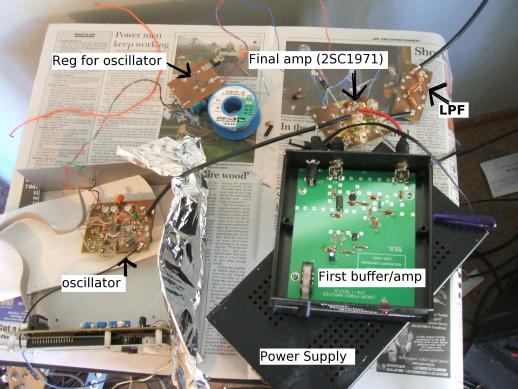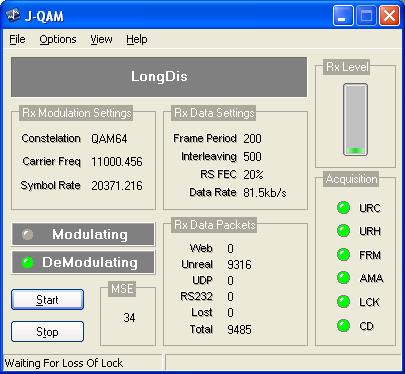How The 1Km JQAM Test Went
Well after some bad weather I finally got a break and some good weather arrived. So I decided that it was a good day to try out how JQAM v2 worked with a 1Km distance.
When creating JQAM most of the time I would just loopback the soundcard with a piece of wire, so the distance i was transmitting in effect was no distance at all. For a real life test I just sent the signals from one end of the house to the other via either wide band FM or NBFM at about 88MHz and 476MHz respectively. All very well in theory but how would it behave traveling a longer distance, through a built up area, through hills, and bouncing off hills. Would it even work at all?
If you've been reading what i've done before you'd know that I've done this test before using an older version of my somewhere. It was an OK test but streaming media dropped out a far bit. With this in mind I went about making JQAM v2 more robust, an hence its existence.
This 1Km distance for me is always a bit tricky to do, I'm surrounded with hills and houses and get no direct line of site at all. I need at least a watt to get any signal at all. My 476MHz transmitters are 1/2 a watt and are very iffy doing the distance. I needed something else. I had to make something that would do the job.
I have bits 'n pieces of RF stuff around, so first I got a RF modulator to work, its PLL'ed. I fed that into a RF amp/buffer to try and boost the signal a tad an stop the darn feedback into the oscillator happening and stopping the oscillator, this went from about 5mW to 125mW. Then into a 2SC1971, this went from 125mW to 4W. Then through a LPF to make the signal pretty. Below is a picture of the transmitter, you can see it's quite a mess :).

Next I needed an aerial. In the garage I found an old car aerial, some pieces of pipe, and a hose pipe clamp. In the house I got some string and one of the grills from the oven. Climbing on the roof and putting it all together I got the following (It's all held together with string btw)

I used UltraVNC so I didn't have to go home every time I wanted to change the transmitter's settings. When I got the the other house I turned JQAM on, QAM16 gamma 0.54 fc 4800 fec 20%. The receiver was just a common FM radio pluged into the soundcard. Started JQAM on the receiver's end, and low and behold it locked no problem. So then I up'd the anti and switched to QAM64, no probs. So then I up'd the carrier frequency all the way to 11000Hz, no probs. It was quite amazing how well it worked, it worked just as well as if I was in the same house as the transmitter.
At this point I was using about 22KHz of bandwidth. My settings were interleaving=500, fec=20%, fc=11000Hz, gamma=0.54, QAM64. This meant I was transmitting 20370 symbols a second, equivalent to 122220 ones and zeros a second. After taking into account of fec and tcm this works out to be a usable 81.5kb/s, witch is about 2 times as fast as a dialup modem can download, pretty good.
Next it was time to see how streaming media worked with the new version of JQAM. I started streaming TV from the capture card at about 70kb/s for video and 10kb/s for voice. This is quite watchable, in fact I sat there and watched TV for about half an hour before heading off home. I didn't get any dropouts while watching TV.


The test really went prefect, I couldn't have hoped for better. I think its so cool that its totally possible to use standard radios for transmitting video at a reasonable rate over what I consider long distances. That you don't have to modify radios to have perfect flat response with no dispersion to do this is just the icing on the cake.
Jonti
06/08/08
Home
(Page done in Linux, Slax, very nice operating system)